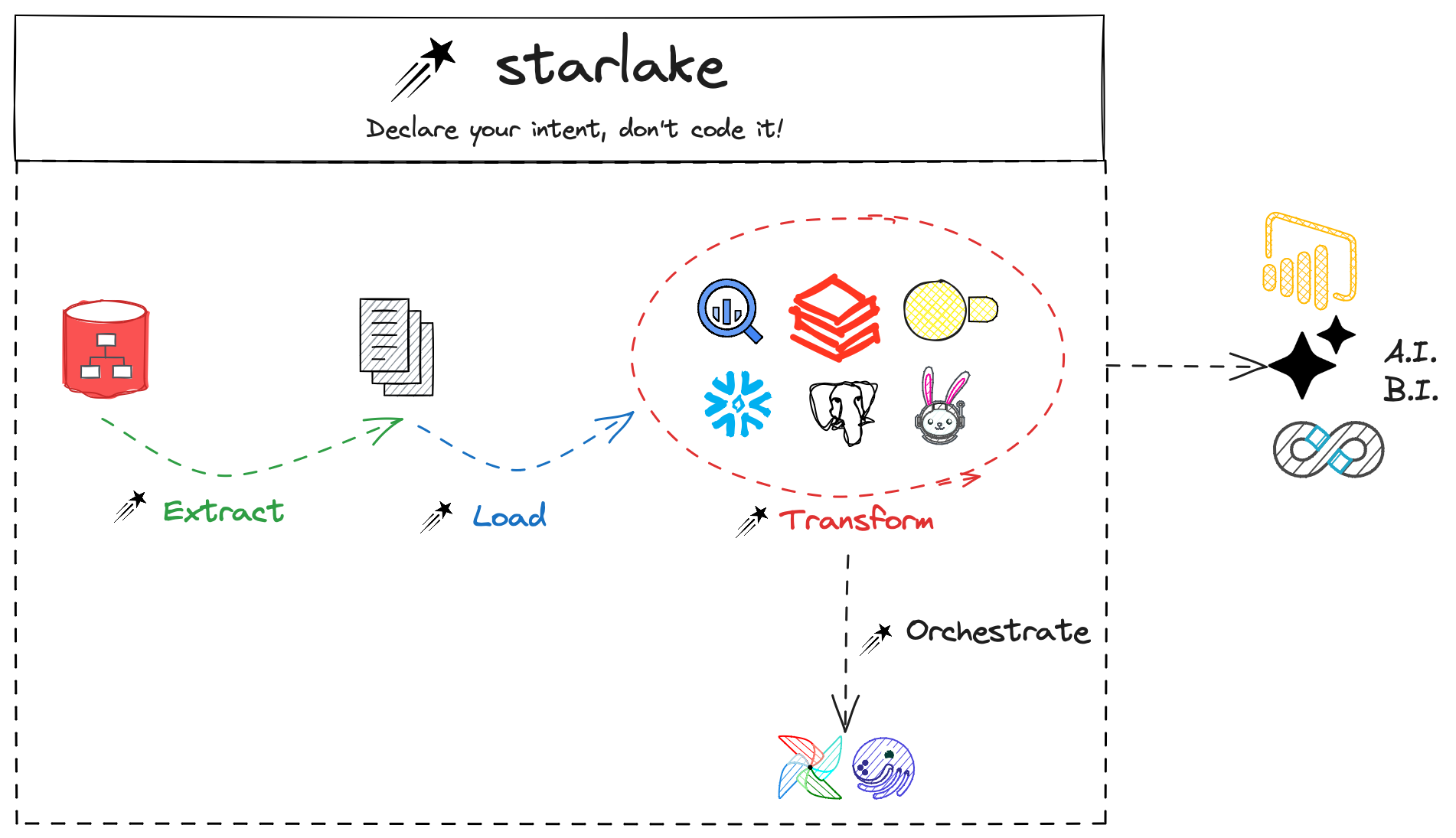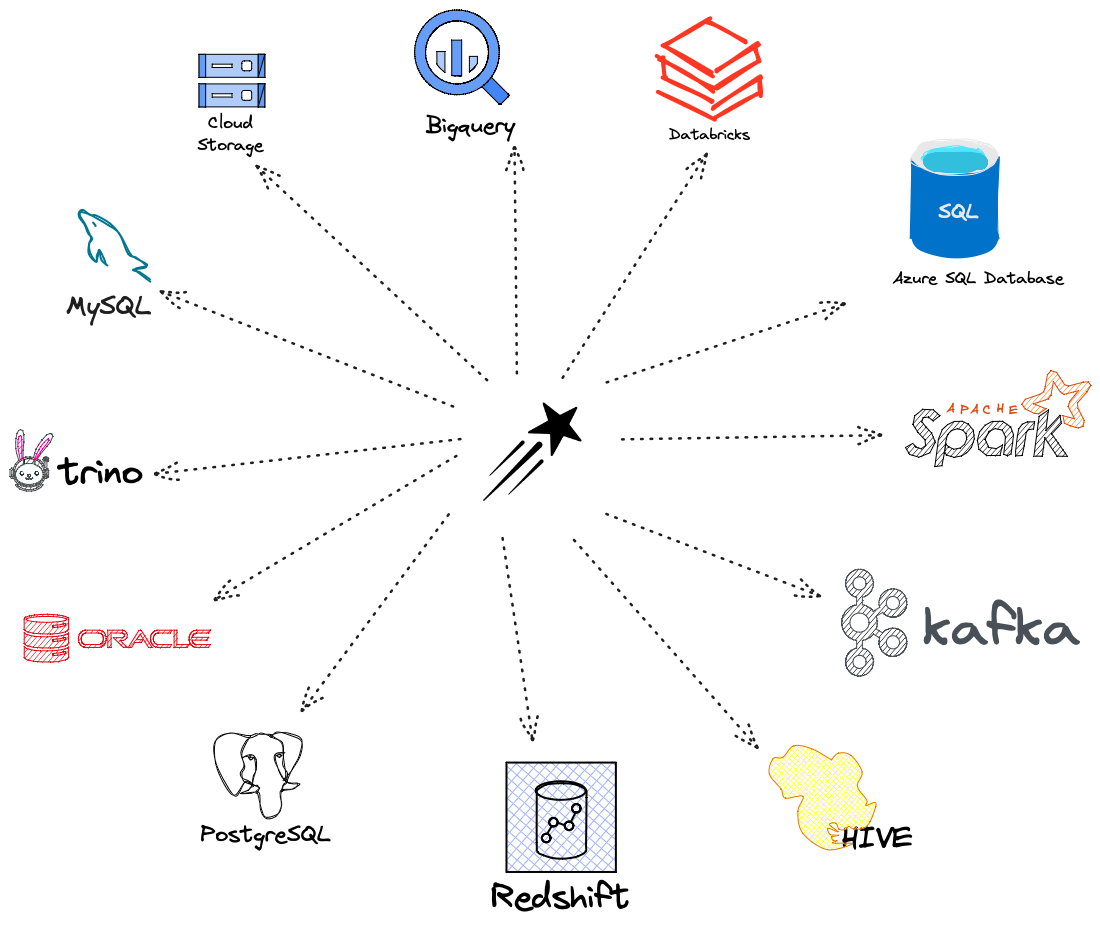Starlake is a declarative text based tool that enables analysts and engineers to extract, load, transform and orchestrate their data pipelines.
Starlake is a configuration only Extract, Load, Transform and Orchestration Declarative Data Pipeline Tool. The workflow below is a typical use case:
- Extract your data as a set of Fixed Position, DSV (Delimiter-separated values) or JSON or XML files
- Define or infer table schemas fom text files (csv, json, xml, fixed-width ...)
- Load: Define transformations at load time using YAML and start loading files into your datawarehouse.
- Transform: Build aggregates using regular SQL SELECT statements and let Starlake build your tables with respect to your selected strategy (Append, Overwrite, Merge ...).
- Orchestrate: Let Starlake handle your data lineage and run your data pipelines on your favorite orchestrator (Airflow, Dagster ... ).
You may use Starlake for Extract, Load and Transform steps or any combination of these steps.
The advent of declarative programming, exemplified by tools like Ansible and Terraform, has revolutionized infrastructure deployment by allowing developers to express intended goals without specifying the order of code execution. This paradigm shift brings forth benefits such as reduced error prone coding tasks, significantly shortened development cycles, enhanced code readability, and increased accessibility for developers of all levels.
Starlake is a YAML-based declarative tool designed for expressing Extract, Load, Transform, and Orchestration tasks. Drawing inspiration from the successes of declarative programming in infrastructure, Starlake aims to bring similar advantages to the realm of data engineering.
This paradigm shift encourages a focus on defining goals for data warehouses, rather than the intricacies of implementation details.
The YAML DSL is self-explanatory and easy to understand. This is best explained with an example:
Let's say we want to extract data from a Postgres Server database on a daily basis
extract:
connectionRef: "pg-adventure-works-db" # or mssql-adventure-works-db i extracting from SQL Server
jdbcSchemas:
- schema: "sales"
tables:
- name: "salesorderdetail" # table name or simple "*" to extract all tables
partitionColumn: "salesorderdetailid" # (optional) you may parallelize the extraction based on this field
fetchSize: 100 # (optional) the number of rows to fetch at a time
timestamp: salesdatetime # (optional) the timestamp field to use for incremental extraction
tableTypes:
- "TABLE"
#- "VIEW"
#- "SYSTEM TABLE"
#- "GLOBAL TEMPORARY"
#- "LOCAL TEMPORARY"
#- "ALIAS"
#- "SYNONYM"That's it, we have defined our extraction pipeline.
Let's say we want to load the data extracted from the previous example into a datawarehouse
---
table:
pattern: "salesorderdetail.*.psv" # This property is a regular expression that will be used to match the file name.
schedule: "when_available" # (optional) cron expression to schedule the loading
metadata:
mode: "FILE"
format: "CSV" # (optional) auto-detected if not specified
encoding: "UTF-8"
withHeader: yes # (optional) auto-detected if not specified
separator: "|" # (optional) auto-detected if not specified
writeStrategy:
type: "UPSERT_BY_KEY_AND_TIMESTAMP"
timestamp: signup
key: [id]
# Please replace it by the adequate file pattern eq. customers-.*.psv if required
attributes: # Description of the fields to recognize
- name: "id" # attribute name and column name in the destination table if no rename attribute is defined
type: "string" # expected type
required: false # Is this field required in the source (false by default, change it accordingly) ?
privacy: "NONE" # Should we encrypt this field before loading to the warehouse (No encryption by default )?
ignore: false # Should this field be excluded (false by default) ?
- name: "signup" # second attribute
type: "timestamp" # auto-detected if specified
- name: "contact"
type: "string"
...That's it, we have defined our loading pipeline.
Let's say we want to build aggregates from the previously loaded data
transform:
default:
writeStrategy:
type: "OVERWRITE"
tasks:
- name: most_profitable_products
writeStrategy:
type: "UPSERT_BY_KEY_AND_TIMESTAMP"
timestamp: signup
key: [id]SELECT # the SQL query will be translated into the appropriate MERGE INTO or INSERT OVERWRITE statement
productid,
SUM(unitprice * orderqty) AS total_revenue
FROM salesorderdetail
GROUP BY productid
ORDER BY total_revenue DESCStarlake will automatically apply the right merge strategy (INSERT OVERWRITE or MERGE INTO) based on writeStrategy property and the input /output tables .
Starlake will take care of generating the corresponding DAG (Directed Acyclic Graph) and will run it whenever the tables referenced in the SQL query are updated.
Starlake comes with a set of DAG templates that can be used to orchestrate your data pipelines on your favorite orchestrator (Airflow, Dagster, ...). Simply reference them in your YAML files and optionally customize them to your needs.
The following dependencies are extracted from your SQL query and used to generate the corresponding DAG:
The resulting DAG is shown below:
The Load & Transform steps support multiple configurations for inputs and outputs.
Complete documentation available here





